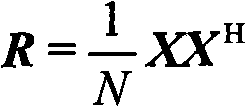Self-adaption anti-coherent interference technology based on characteristic component rejection
An interference technology and self-adaptive technology, applied in radio wave measurement systems, instruments, etc., can solve the problems of large amount of calculation and large number of samples, and achieve the effect of small amount of calculation, simple equipment and good receiving performance
- Summary
- Abstract
- Description
- Claims
- Application Information
AI Technical Summary
Problems solved by technology
Method used
Image
Examples
Embodiment Construction
[0032] Implement the principle of the present invention as follows:
[0033] Aiming at the fact that non-coherent interference is often much larger than expected signal and coherent interference in the actual environment, the present invention proposes a new adaptive anti-coherent interference technology based on feature component elimination. This technology first estimates the eigenvector corresponding to the composite signal of the desired signal and coherent interference, and after discarding the contribution of this part of the signal in the covariance matrix, then performs adaptive weighting and cancellation processing. The rationale of this approach is that when there is a difference in signal power (including the desired signal and the interference signal), there is a one-to-one correspondence between the eigenvector corresponding to the large eigenvalue of the data covariance matrix and the signal-steering vector. The vectors may respectively reflect corresponding sig...
PUM
 Login to View More
Login to View More Abstract
Description
Claims
Application Information
 Login to View More
Login to View More - R&D
- Intellectual Property
- Life Sciences
- Materials
- Tech Scout
- Unparalleled Data Quality
- Higher Quality Content
- 60% Fewer Hallucinations
Browse by: Latest US Patents, China's latest patents, Technical Efficacy Thesaurus, Application Domain, Technology Topic, Popular Technical Reports.
© 2025 PatSnap. All rights reserved.Legal|Privacy policy|Modern Slavery Act Transparency Statement|Sitemap|About US| Contact US: help@patsnap.com



